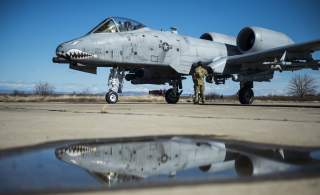America's Mighty A-10 Warthog vs. Iran's 'Swarm' Boats: Who Wins?
Defeating swarms with A-10 Warthogs isn’t exactly revolutionary but that isn’t so much a problem. The plane isn’t a high-tech laser, but it doesn’t need to be.
The Air Force had been trying to kill its A-10 attack planes for years — the branch prefers stealthy fighters and bombers — but pressure from Congress and continued relevance in the wars in Iraq and Afghanistan have kept the Warthogs flying. Perhaps stopping a boat swarm from overwhelming an American cruiser or destroyer might keep them going for a bit longer.
It doesn’t necessarily take the resources of a major nation-state to challenge U.S. Navy warships. China for instance is building up a large navy and invests in long-range, ship-killing missiles. Iran can’t build a large navy but it does invest in swarms of small missile boats.
Like a swarm of insects, a swarm of boats can pose a threat as a larger, far more expensive warship might not be able to swat them all — and a single missile with enough punch can be devastating.
So the U.S. military is practicing with ways to defeat such a potential threat with tank-killing A-10 Warthogs.
(This first appeared in 2017.)
On Feb. 6, the low- and slow-flying Warthogs together with Canadian CF-18 Hornets carried out simulated attacks on dozens of boats in Florida’s Choctawatchee Bay. The planes didn’t drop any ordnance, however, as the boats were being piloted by local captains hired by the Air Force.
These were simply mock attack runs. An Air Force news release also noted that the civilian sailors practiced “realistic swarm attack formation maneuvers” with mocked-up machine guns fitted to their boats.
The 1980s-vintage Warthogs — built around a 30-millimeter rotary cannon and capable of carrying a variety of bombs and missiles — did fire inert rounds on unmanned boats at a different time during the exercise. The munitions expended during that other phase of the exercise also included delta-wing AGM-65 Maverick missiles and 500-pound laser-guided bombs.
“We evaluate precision guided munitions against realistic targets with realistic enemy defenses,” Lt. Col. Sean Neitzke of the 86th Fighter Weapons Squadron said.
“There are plenty of places in the world where low-tech adversaries can mount 50-caliber machine guns and rocket launchers on small boats for use against us. They could also use other types of shoulder launched weapons, all of which could be a threat to American assets.”
The Air Force had been trying to kill its A-10 attack planes for years — the branch prefers stealthy fighters and bombers — but pressure from Congress and continued relevance in the wars in Iraq and Afghanistan have kept the Warthogs flying. Perhaps stopping a boat swarm from overwhelming an American cruiser or destroyer might keep them going for a bit longer.
Recommended: What Will the Sixth-Generation Jet Fighter Look Like?
Recommended: Imagine a U.S. Air Force That Never Built the B-52 Bomber
Recommended: Russia's Next Big Military Sale - To Mexico?
Interestingly, A-10s carrying out maritime attack missions is an old-school role for the plane, as the Warthog was originally envisioned in part as a sea attacker. But it has overwhelmingly fought on land with rare exceptions. For instance, A-10s attacked small boats during the 2011 Libyan intervention.
Even Tom Clancy envisioned ship-killing Warthogs staging a show-of-force near a Soviet carrier in his 1984 novel The Hunt for Red October.
By the way, the Air Force is exploring other ways of deploying the ungainly attackers over the oceans — sending four of them in April 2016 on patrol over the South China Sea, which Beijing is colonizing and militarizing through the construction of artificial islands. China’s Maritime Militia also practices its own version of swarming.
Meanwhile, the U.S. Navy has been testing its 30-kilowatt Laser Weapon System which it deployed aboard the amphibious ship USS Ponce based in the Middle East. But the laser, while operational, is one-of-a-kind.
All the while, the Iranian navy has continued to harass U.S. Navy vessels with small speedboats using swarming-style tactics. In August 2016, Iran harassed U.S. ships four times in a single week. During a shooting war, these swarms could threaten the strategic Strait of Hormuz — where a hefty chunk of the world’s oil passes through.
Defeating swarms with A-10 Warthogs isn’t exactly revolutionary but that isn’t so much a problem. The plane isn’t a high-tech laser, but it doesn’t need to be.
This first appeared in WarIsBoring here.


